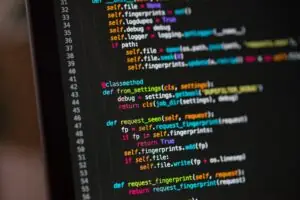In C programming, pointers stand out as a unique and powerful feature. A pointer in C is essentially a variable that holds the memory address of another variable. This capability of storing addresses rather than values themselves opens up numerous possibilities, from simple to complex operations in C programming. Pointers provide a way to directly interact with memory locations, thus offering a higher degree of control and efficiency in code. Understanding pointers is crucial for mastering C, as they are used extensively in various aspects of the language, including memory management, data structures, and algorithm optimization.
The Fundamentals of Pointers
A pointer in C is defined by specifying the data type of the variable whose address it will hold. This aligns with the principle that in C, every variable is a specific data type, whether it’s a primitive data type like int, char, float, or a derived data type like structures. The syntax of pointers is straightforward yet vital for correct usage. A pointer is declared using the asterisk (*) symbol, followed by the pointer name. For instance, int *ptr; declares a pointer to an integer. Initialization of pointers is another key aspect, as unassigned pointers, often referred to as wild pointers, can lead to program crashes if used unintentionally.
Pointer Dereferencing and Double Pointers
Dereferencing a pointer means accessing the value at the memory address stored in the pointer. This is done using the same asterisk (*) symbol used in the declaration but in a different context. For example, if ptr holds the address of a variable var, *ptr will give you the value of var. A more advanced concept is that of double-pointers, or pointers-to-pointer, denoted by **. These are used to store the address of another pointer, allowing for multiple layers of indirection. Double pointers are particularly useful in dynamic memory allocation and handling arrays of strings.
Pointers and Memory Addresses
Every variable in a C program is stored in a memory location, and each location is assigned a unique memory address. Pointers are essentially variables that store these memory addresses. This direct interaction with memory addresses is what makes pointers in C so powerful. Pointers allow for efficient manipulation of data, especially in large programs or systems where memory management is crucial.
Types of Pointers in C
C programming language supports various types of pointers, each with its specific use cases. The most common type is the basic pointer, which points to variables of primitive data types like int, char, or float. Then, there are function pointers, which, as the name suggests, point to functions. Function pointers are incredibly useful in scenarios like callback functions and implementing function tables. Another important type is the NULL pointer, a special type of pointer that is used to signify that a pointer does not hold a valid memory address. Assigning NULL to pointers when they are not in use is a good practice in C programming.
Pointers and Functions
Function pointers in C add a layer of flexibility to the programming language. They allow functions to be passed as arguments to other functions, returned from functions, and stored in arrays. This can lead to more dynamic and versatile code. The syntax for declaring a function pointer can be a bit daunting at first, but it follows the logic of pointer syntax. For instance, int (*funcPtr)(int); declares a function pointer that points to a function taking an int as an argument and returning an int.
The Importance of Pointers in C Programming
Pointers are a cornerstone in C programming, offering the capability to directly manipulate memory, which is crucial for system-level programming. They provide a way to efficiently handle dynamic memory allocation, which is essential in scenarios where the memory needs of a program cannot be determined before runtime. Furthermore, pointers are instrumental in the implementation of complex data
structures like linked lists, trees, and graphs. In these structures, pointers are used to dynamically allocate memory for nodes and to establish links between them, allowing for flexible and efficient manipulation of these structures.
Pointer-to-Pointer Concept and Applications
The concept of double-pointers or pointer-to-pointers in C adds another dimension to pointer usage. This concept involves a pointer pointing to another pointer, thereby creating multiple levels of indirection. This is particularly useful in scenarios where you need to modify the address stored in a pointer, or when working with multidimensional arrays. Double pointers are extensively used in dynamic data structures, where they can create and manage dynamic arrays or matrices.
In real-life applications, pointers are indispensable in systems programming, such as operating system development and embedded system programming. They provide a way to directly interact with and manage system resources, which is essential in low-level programming. In application development, pointers are used for optimizing performance, especially in memory-intensive tasks. Additionally, pointers play a crucial role in network communication and in handling data received from hardware devices, where direct memory access is often necessary.
Null, Void, and Wild Pointers
In C programming, special attention needs to be given to null pointers, void pointers, and wild pointers. A null pointer is a pointer that points to nothing and is often used to initialize pointers or to check if a pointer is valid. Void pointers, on the other hand, are used for generic type handling, allowing a single pointer to point to any data type. Wild pointers, which are uninitialized pointers, can lead to unpredictable behavior and bugs, and hence need to be managed carefully.
The Versatility of Void Pointers
Void pointers, also known as generic pointers, are a type of pointer that can point to any data type. In C, void pointers are used when an exact data type is not known or needs to be generalized. They are frequently used in functions that accept different data types and in dynamic memory allocation. However, before a void pointer can be dereferenced, it must be typecasted to a specific data type pointer.
Conclusion
In conclusion, pointers are one of the most powerful features of the C programming language. They offer direct access to memory addresses, which enables efficient manipulation of data and memory. Understanding pointers, including their types like function pointers, null pointers, void pointers, and double pointers, is essential for anyone looking to master C programming. The proper use of pointers can lead to highly efficient and flexible code, making them a key tool in the arsenal of any C programmer.
Understanding and utilizing pointers effectively can unlock the full potential of C programming, allowing for the development of robust, efficient, and flexible applications. Whether it’s in system-level programming, handling dynamic data structures, or optimizing performance, pointers are an indispensable part of C that every programmer should be proficient in.
FAQ
Follow us on Reddit for more insights and updates.





Comments (0)
Welcome to A*Help comments!
We’re all about debate and discussion at A*Help.
We value the diverse opinions of users, so you may find points of view that you don’t agree with. And that’s cool. However, there are certain things we’re not OK with: attempts to manipulate our data in any way, for example, or the posting of discriminative, offensive, hateful, or disparaging material.